 |
Top Destinations |
|
|
|
 |
Travel Tools |
|
|
|
 |
|
|
Hong Kong Attractions - Sightseeing and top things to
see
 Aberdeen lies tucked away on the southern reaches of Hong Kong Island.
Two centuries ago it was a refuge for pirates. Later it became a centre
for incense production. Later still its name - Heung Gong, or Fragrant
Harbour was anglicised and applied to the whole city. More recently it
was a simple fishing village. Today Aberdeen is a modern town, with streets
full of high-rise buildings, and its vibrant waterfront home to the yachts
of Hong Kong's rich and famous. Traditional and often impoverished ways
of life still prevail, however, none more striking than the harbour's
hundreds of junks and sampans, old-fashioned boats which provide floating
homes for thousands of people. Taking a ride on one of the boats is a
popular activity - you will inevitably be approached by people trying
to sell you a trip - but try to stick with licensed operators. Alternatively
take a shuttle boat to one of the harbour's famous'floating restaurants',
vast and gaudily decorated affairs aimed unashamedly at tourists, but
fun nevertheless.
Aberdeen lies tucked away on the southern reaches of Hong Kong Island.
Two centuries ago it was a refuge for pirates. Later it became a centre
for incense production. Later still its name - Heung Gong, or Fragrant
Harbour was anglicised and applied to the whole city. More recently it
was a simple fishing village. Today Aberdeen is a modern town, with streets
full of high-rise buildings, and its vibrant waterfront home to the yachts
of Hong Kong's rich and famous. Traditional and often impoverished ways
of life still prevail, however, none more striking than the harbour's
hundreds of junks and sampans, old-fashioned boats which provide floating
homes for thousands of people. Taking a ride on one of the boats is a
popular activity - you will inevitably be approached by people trying
to sell you a trip - but try to stick with licensed operators. Alternatively
take a shuttle boat to one of the harbour's famous'floating restaurants',
vast and gaudily decorated affairs aimed unashamedly at tourists, but
fun nevertheless.
Other things to see include the traditional boatyards of Ap Lei Chau across
the harbour (access by boat or bridge) and the Tin Hau Temple (1851),
the latter dedicated to the Queen of Heaven (or Goddess of the Sea), protector
of seafarers. A statue of the goddess stands inside the temple flanked
by two generals: one who can hear clearly and another who can see clearly.
Hung Hsing, another small temple at the southern end of the main street,
is also worth visiting.
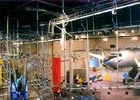 Hong Kong Science Museum is situated in a suitably futuristic-looking
building on the eastern fringes of the Tsim Sha Tsui district, and has
managed in a short time - despite its slightly outlying location - to
become one of the city's most popular sights. Children are likely to find
it especially appealing. You could happily spend several hours exploring
its three floors, either casting your eye over the 500 major exhibits
or getting to grips with some of the many interactive and audio-visual
displays. It's well worth avoiding some of the busier periods - mid-morning
and most of Sunday - when you may have to wait in line for some of the
more popular exhibits.
Hong Kong Science Museum is situated in a suitably futuristic-looking
building on the eastern fringes of the Tsim Sha Tsui district, and has
managed in a short time - despite its slightly outlying location - to
become one of the city's most popular sights. Children are likely to find
it especially appealing. You could happily spend several hours exploring
its three floors, either casting your eye over the 500 major exhibits
or getting to grips with some of the many interactive and audio-visual
displays. It's well worth avoiding some of the busier periods - mid-morning
and most of Sunday - when you may have to wait in line for some of the
more popular exhibits.
Almost anything with an even vaguely scientific bent qualifies for attention.
The workings of the most basic everyday appliances are explained - items
from your kitchen or bathroom, for example - as are the intricacies of
more advanced disciplines such as robotics and computer science. Special
attention is paid to branches of technology beloved of Hongkongers, notably
cellular phones and fax machines: the city has the world's highest per
capita number of cellular phones and pagers - 680,000 in 1995, or one
for every five people - and the world's second highest rate of fax penetration
(over 270,000 dedicated lines). Scientific history is not forgotten, however,
and the museum's exhibits include a miniature submarine, several early
computers and the DC3 aeroplane that launched the now famous Cathay Pacific
airline.
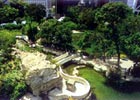 Shopping and high-rise modern architecture can only hold your attention
for so long, which makes Hong Kong's principal park a welcome and rather
unexpected relief from the city's many urban distractions. Spread over
10ha, the park opened in 1991 on the site of the old Victoria Barracks,
and in its layout deliberately avoided a strictly naturalistic appearance
in favour of a partially artificial approach to landscaping (much of the
area's original vegetation had long-since vanished in any case). Skilful
design work has artfully folded the park into the contours of the surrounding
hillside, dramatically juxtaposing the ranks of skyscrapers on one side
with almost open hilly slopes on the other.
Shopping and high-rise modern architecture can only hold your attention
for so long, which makes Hong Kong's principal park a welcome and rather
unexpected relief from the city's many urban distractions. Spread over
10ha, the park opened in 1991 on the site of the old Victoria Barracks,
and in its layout deliberately avoided a strictly naturalistic appearance
in favour of a partially artificial approach to landscaping (much of the
area's original vegetation had long-since vanished in any case). Skilful
design work has artfully folded the park into the contours of the surrounding
hillside, dramatically juxtaposing the ranks of skyscrapers on one side
with almost open hilly slopes on the other.
Among the park's many features are lakes, artificial waterfalls, numerous
plants (look out for the giant bamboo in particular), a visual arts centre,
children's playground, restaurant, viewing tower, tai chi garden and the
outstanding Museum of Tea Ware in Flagstaff House at the park's northern
tip. Museum aside, the park's highlights are its many peaceful corners,
a large aviary and a modern conservatory, the last - the largest in Southeast
Asia - home to 200 plant species divided into tropical and semi-arid varieties.
The still more impressive aviary repli- cates a tropical rainforest habitat,
tree-high walkways bringing you into close contact with some 150 species
of (and 500 individual) exotic and brightly coloured birds as you drop
down through the complex.
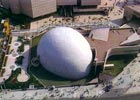 HongKong Space Museum opened in 1980 and was an immediate success, especially
among children, thanks largely to its fascinating exhibits and the wide
range of its mainly hands-on displays. It has three principal sections:
the Hall of Astronomy, the Hall of Space Science and the combined Planetarium
and Omnimax Theatre (the Space Theatre). Most people are tempted by the
last, and in particular by the Omnimax Theatre, where special-format films
- mostly on space, sport and the natural world - are shown on a huge screen.
The Theatre has around seven shows daily (except Tuesday), including some
in Cantonese, for which headphone translations are available.
HongKong Space Museum opened in 1980 and was an immediate success, especially
among children, thanks largely to its fascinating exhibits and the wide
range of its mainly hands-on displays. It has three principal sections:
the Hall of Astronomy, the Hall of Space Science and the combined Planetarium
and Omnimax Theatre (the Space Theatre). Most people are tempted by the
last, and in particular by the Omnimax Theatre, where special-format films
- mostly on space, sport and the natural world - are shown on a huge screen.
The Theatre has around seven shows daily (except Tuesday), including some
in Cantonese, for which headphone translations are available.
Elsewhere, the exhibits of the Space Science hall include pieces of moon
rock, a mock-up of the Space Shuttle and the original Mercury space capsule
used by astronaut Scott Carpenter in 1962. A variety of video, push- button
and advanced audio-visual displays provides plenty of absorbing and educational
titbits, with a particular emphasis on Chinese contributions to astronomy
across the centuries.
Among other things you learn that it was the Chinese who first recorded
Halley's Comet, were the first to use gunpowder (and thus lay the foundations
of rocket science) and the first to map the movement of the heavens.
Other exhibits concentrate on solar science, providing background to phenomena
such as sun spots and solar eclipses. There's also the chance to look
through a telescope specially adapted for looking at the sun.
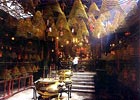 Hong Kong's oldest and most famous temple (cl847) is dedicated to two
gods, one civilian, the other military: Man, or Man Cheong, the god of
literature, and Mo, or Kuan Ti, the god of war. Figures of each stand
on the main altar, Man dressed in green holding a writing brush and Mo
arrayed in red brandishing a sword. Man (literally 'civil') was a 3rd-century
BC Chinese statesman, Mo ('militay'), a 2nd-century AD Chinese soldie.
Man is the traditional protector of civil servants, Mo - worshipped by
Taoists and Buddhists alike - the guardian of armies, policemen, secret
societies and pawnbrokers. Lesser gods lie ranged beside the temple's
altar statues, notably Pao Wong, the god of justice, and Shing Wong, a
god who keeps watch over the surrounding district.
Hong Kong's oldest and most famous temple (cl847) is dedicated to two
gods, one civilian, the other military: Man, or Man Cheong, the god of
literature, and Mo, or Kuan Ti, the god of war. Figures of each stand
on the main altar, Man dressed in green holding a writing brush and Mo
arrayed in red brandishing a sword. Man (literally 'civil') was a 3rd-century
BC Chinese statesman, Mo ('militay'), a 2nd-century AD Chinese soldie.
Man is the traditional protector of civil servants, Mo - worshipped by
Taoists and Buddhists alike - the guardian of armies, policemen, secret
societies and pawnbrokers. Lesser gods lie ranged beside the temple's
altar statues, notably Pao Wong, the god of justice, and Shing Wong, a
god who keeps watch over the surrounding district.
A visit here is a must if you want to savour the flavour of a Taoist temple
(albeit one with Buddhist overtones), the atmosphere mystical but oddly
casual, the dusky air pungent with the scent of incense burning from huge
coils hung from the roof. A bell and drum by the entrance sound when a
prayer or offering is made - usually fruit or sticks of incense. The large
bell, cast in Guangzhou (Canton), dates from 1846, its smaller neighbour,
on the left, from 1897. Also look out for the two antique sedans under
glass by the altar, originally used to carry the statues of Man and Mo
during ceremonial processions.
 Visitors who take no other excursion in Hong Kong often make the effort
to see Stanley, a coastal village on the southern side of Hong Kong Island.
Most are drawn as much by the scenery en route and the reputation of its
famous market as by any preponderance of attractions to visit or activities
to do once they get there.
Visitors who take no other excursion in Hong Kong often make the effort
to see Stanley, a coastal village on the southern side of Hong Kong Island.
Most are drawn as much by the scenery en route and the reputation of its
famous market as by any preponderance of attractions to visit or activities
to do once they get there.
One of the island's oldest communities, Chek Chue (Robber's Lair), as
it was then known, already had a population of around 2,000 when the British
arrived in 1841 . Later it became an important British military garrison,
becoming involved in bitter fighting during the Japanese invasion in 1941
. The poignant and beautifully kept Military Cemetery, a short walk north
of the village, is well worth a visit.
Most people come here for the market, however, located just up the road
from the harbour. Over the years it's become known for its bargain clothes,
though these days prices are not as keen as they were. It's still fun
to browse, however, and the stalls are as good a place as anywhere in
Hong Kong to buy souvenir T-shirts or inexpensive Chinese artefacts and
household goods. After seeing the market wander down to Stanley's waterfront
Main Street, lined with bars, pubs and restaurants popular with ex-pats.
At its western end stands the Tin Hau Temple (1767), one of the oldest
in Hong Kong. Around a kilometre to the south lies St Stephen's Beach,
which is nicer than the more convenient Stanley Main Beach.
 The Hong Kong Museum of Art opened in 1989 as part of the city's superb
new Cultural Centre. Ranged over five floors, it is divided into six separate
galleries, the majority of which are devoted to Chinese art and artefacts
from the past. Room is also found, however, for a range of contemporary
and Western art, as well as for a variety of temporary exhibitions.
The Hong Kong Museum of Art opened in 1989 as part of the city's superb
new Cultural Centre. Ranged over five floors, it is divided into six separate
galleries, the majority of which are devoted to Chinese art and artefacts
from the past. Room is also found, however, for a range of contemporary
and Western art, as well as for a variety of temporary exhibitions.
Among the art galleries the undoubted highlight is the third floor's Historical
Pictures Collection, home to more than a thousand paintings, drawings
and prints devoted almost entirely to topographical scenes of Hong Kong
and its immediate surroundings. Among them is the first known painting
of Hong Kong, an Aberdeen waterfall scene executed by William Havell in
1816. This and other paintings provide a fascinating documentary narrative
of Hong Kong over the decades, from the days when it amounted to little
more than sandy beaches and a handful of waterfront buildings. Elsewhere,
be certain to some spend time in the gallery devoted to Chinese antiquities,
a collection containing over 3,000 wide-ranging artefacts. Of panicular
interest are two Tang Dynasty tomb guardians (AD 618-906), pot-bellied
figures in the form of mythical beasts. Also look out for the almost translucent
rhino-horn cups, prized for their reputed ability to advertise the presence
of poison.
Other exhibits trace the development of porcelain and crafts such as bamboo
carving, lacquer work and metal casting, while the Decorative Arts section
contains, among other things, mouthwatering displays of jade, ivory, glassware
and Ming Dynasty ceramics.
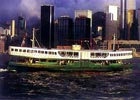 The Star Ferry has linked Hong Kong Island and Kowloon since 1898. For
just a couple of dollars you are treated to one of the world's most spectacular
ferry rides, the robust little green and white boats dodging the intense
water- borne traffic on what was once the world's finest and busiest deep-water
anchorage.
The Star Ferry has linked Hong Kong Island and Kowloon since 1898. For
just a couple of dollars you are treated to one of the world's most spectacular
ferry rides, the robust little green and white boats dodging the intense
water- borne traffic on what was once the world's finest and busiest deep-water
anchorage.
Strictly speaking there are several Star Ferries, each plying slightly
different routes across the harbour. The route everybody rides, however,
is the one between the piers on Kowloon close to the Cultural Centre and
the heart of the Central district on Hong Kong Island. The trip takes
around seven minutes, and you can choose between upper and lower decks,
the upper deck costing a few cents more. You enter the quay via coin-operated
turnstiles, so be sure to have some change, and then wait with the chaotic-looking
crowds for the next boat (queue at a ticket office by the turnstiles if
you have no change). If boats are full - and numbers are monitored - simply
wait a few minutes for the next ferry.
Once underway it's difficult to know where to look. Behind and in front
of you skyscrapers rise from the water- front, combining with the hills
behind to produce one of the world's most spectacula city skylines. Below
and all around you the water is alive with countless boats, while on board
the massed ranks of passengers provide a people-watching spectacle in
their own right.
 Since its opening in 1977, Ocean Park has mushroomed into a vast complex
of attractions overlooking the sea on the southern side of Hong Kong Island.
Foremost among these are an amusement park, oceanarium and open-air theme
park, an ensemble which together attracts well over three million visitors
a year. It's a great place to visit with children, offering enough to
keep you occupied for at least a day. It's also busy, however, especially
in summer and at weekends and public holidays, when the chances are you
will have to wait in line for the most popular rides.
Since its opening in 1977, Ocean Park has mushroomed into a vast complex
of attractions overlooking the sea on the southern side of Hong Kong Island.
Foremost among these are an amusement park, oceanarium and open-air theme
park, an ensemble which together attracts well over three million visitors
a year. It's a great place to visit with children, offering enough to
keep you occupied for at least a day. It's also busy, however, especially
in summer and at weekends and public holidays, when the chances are you
will have to wait in line for the most popular rides.
You start at Lowland, offering many attractions, including parks, gardens,
a butterfly house and an adventure playground. From here an exhilarating
cable-car ride takes you over the sea to the Headland section, where you'll
find many of the amusement park rides (notably the electrifying Crazy
Galleon and 80kph Dragon roller-coaster), the Ocean Theatre {home to performing
dolphins, killer whales and high divers), a large aquarium, a seal and
penguin sanctuary, and the 72m Ocean Park Tower (which offers superb views
of the coast). From here you ride down the world's longest outdoor escalator
to the Middle Kingdom, a theme park which employs arts, crafts, live theatre,
opera performances and other displays designed to provide a 'living history
of Chinese culture'. Adjacent to Ocean Park and under the same management
lies the equally popular Water World, a fabulous collection of giant water
slides, chutes, swimming pools and other watery attractions.
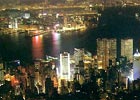 Few cityscapes are as spellbinding as the view of Hong Kong from the Peak
(552m), the green-swathed mountain that looms above Central's tight-packed
ranks of skyscrapers. Cool, clear and removed from the city's bustle,
the area has long been one of the city's most exclusive retreats: the
former British Governor had a summer residence here (damaged during the
Japanese occupation) while the handful of grand houses scattered across
the slopes are by far the city's most coveted.
Few cityscapes are as spellbinding as the view of Hong Kong from the Peak
(552m), the green-swathed mountain that looms above Central's tight-packed
ranks of skyscrapers. Cool, clear and removed from the city's bustle,
the area has long been one of the city's most exclusive retreats: the
former British Governor had a summer residence here (damaged during the
Japanese occupation) while the handful of grand houses scattered across
the slopes are by far the city's most coveted.
A path was cleared to the summit as early as 1859 - a sedan chair was
then the preferred mode of transport- while road access was secured in
1924. Most people today ride up on the famous Peak Tram, built in 1888,
an impossibly steep but wonderful way to reach the Peak Tower, a small
complex of shops, caf??|s and other minor attractions at the tram's upper
terminal. Sit on the right of the tram for the best views, and be certain
to wait for a clear day to make the trip. Do not leave the Tower complex
- which is a little disorientating - without riding the escalators to
the outdoor observation deck: the views are breathtaking.
Across the road from the Tower lies the Peak Galleria, another mall complex,
though your time will be better spent walking all or part way around the
Peak. The full walk takes around an hour, but is easy and straight- forward,
and the views, not to mention the lovely wooded countryside, are a revelation.
|
|
 |
Travel
Guides |
|
|
 |
|

